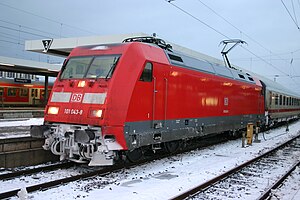DB Class 101
 |
|||||||||||||||||||||||
|
|||||||||||||||||||||||
|
|||||||||||||||||||||||
|
|||||||||||||||||||||||
| Type and origin | |
|---|---|
| Power type | Electric |
| Builder | ADtranz |
| Model | 101 |
| Build date | 1996–99 |
| Total produced | 145 |
| Specifications | |
|---|---|
| AAR wheel arr. | B-B |
| UIC class | Bo'Bo' |
| Gauge | 1,435 mm (4 ft 8 1⁄2 in) standard gauge |
| Length | 19,100 mm (62 ft 8 in) |
| Loco weight | 83 t (82 long tons; 91 short tons) |
| Electric system(s) | 15 kV 16.7 Hz AC Catenary |
| Current collection | Pantograph |
| Traction motors | 4FIA 7067 |
| Train brakes | KE-GPR, electric brakes |
| Safety systems | Sifa, PZB, LZB |
| Performance figures | |
|---|---|
| Maximum speed | 220 km/h (136.7 mph) |
| Power output | 6,400 kW (8,583 hp) |
| Tractive effort | 300 kN (67,443 lbf) |
The DB Class 101 is a class of three-phase electric locomotives built by Adtranz and operated by DB Fernverkehr in Germany. 145 locomotives were built between 1996 and 1999 to replace the 30-year-old and aging Class 103 as the flagship of the DB AG, primarily hauling Intercity services. This class encompasses the latest generation of locomotives of the DB.
In the United States, the ALP-46 locomotive is derived from the DB Class 101. Bombardier's TRAXX shares a common heritage.
Around 1990, it became apparent that the current electric locomotives serving the heavy and fast (speeds over 160 km/h or 99 mph) Intercity services, the Class 103, were wearing out. Their annual mileage of up to 350,000 km (217,000 mi), and the faster and heavier trains, for which these units had not been designed, meant increasing wear damage to the control units, traction motors, and bogie frames. In addition, as part of the Program DB 90, and to cut costs, the theory of "Drive to Deterioration" (Fahren auf Verschleiß) was employed, which increased the strain even further.
Another class in similar service, the 60 units of the Class 120 three-phase locomotive, had also reached a stage where both their age and their design meant ever increasing technical problems. Finally, there were 89 locomotives of the former East German class 112, capable of speeds up to 160 km/h (99 mph), but these units were no longer up to date, and were going to require expenditures in terms of cost of upkeep similar to the existing other classes in this service. In addition, this class was something of a political step child, and the DB wished for a truly new design along the lines of the three-phase Class 120 locomotives.
In the beginning of 1991, the DB first called for designs for new high-performance all-purpose locomotives, using the program name Class 121. Designs for an all-purpose three-phase locomotive with an output in excess of 6 megawatts (8,000 horsepower) and top speeds of 200 km/h (120 mph) were offered, which turned out to be much too expensive for the DB. In addition, due to the separation of services into different areas of operation, suddenly an all-purpose locomotive was no longer required.
...
Wikipedia
